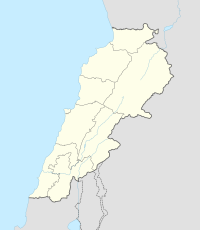Bakka
بكّا Beka, Bekka | |
|---|---|
Village | |
| Country | |
| Governorate | Beqaa Governorate |
| District | Rashaya District |
| Area | |
| • Total | 2.36 sq mi (6.12 km2) |
| Elevation | 4,860 ft (1,480 m) |
| Alternative name | Akbeh, Aqbe, Akbe, Aqbeh |
|---|---|
| Location | 85 kilometres (53 mi) east of Beirut |
| Region | Rashaya |
| Coordinates | 33°35′36″N 35°55′28″E / 33.593334°N 35.924442°E |
| History | |
| Cultures | Roman |
| Site notes | |
| Condition | Ruins |
| Public access | Yes |
Bakka, Bekka or Beka (Arabic: بكّا) is a village and municipality situated 85 kilometres (53 mi) east of Beirut in the Rashaya District of the Beqaa Governorate in Lebanon.[1][2] The population of the village is Sunni.[3]
YouTube Encyclopedic
-
1/3Views:33 1632 2404 345
-
Baalbek بعلبك Temple Complex Tour Lebanon لبنان
-
Discover Lebanon presents Lebanon
-
Driving Anjar عنجر in Lebanon لبنان
Transcription
Wadi Bakka
The Wadi Bakka or Wadi Bekka runs alongside the village. The wadi was the scene of the Battle of Wadi Bakka where a Druze uprising was put down by Ibrahim Pasha of Egypt during the 1838 Druze revolt.[4]
Roman temple
There are the ruins of a Roman temple in the village that are included in a group of Temples of Mount Hermon.[5] George Taylor classified it as a prostylos temple and noted that the north and south walls remained standing and the podium floor had survived. The site has been heavily damaged by local construction of houses over the site. The temple featured an underground crypt that was accessible via one of the houses that had been built over it.[6]
George Taylor divided up the Temples of Lebanon into three groups, one group of Temples of the Beqaa Valley lies north of the road from Beirut to Damascus. Second, there is the group in the area south of the same road, including the Wadi al-Taym and the western flank of Mount Hermon. Third, the group in the area west of a line drawn along the ridge of Mount Lebanon. There are relatively few temples along Lebanon's coastal plain. The Temples of Mount Hermon in Taylor's second group included Bakka and Ain Harcha, Aaiha, Deir El Aachayer, Dekweh, Yanta, Hebbariye, Ain Libbaya, Nebi Safa, Aaqbe, Khirbet El-Knese, Mejdal Anjar, Mdoukha.
Edward Robinson suggested that word bakka could have derived from the later Arabic meaning of crowd. Others have linked it to the Hebrew word bikha meaning plain.[7]
References
- ^ Daniel M. Krencker; Willy Zschietzschmann (1938). Römische Tempel in Syrien: nach Aufnahmen und Untersuchungen von Mitgliedern der Deutschen Baalbekexpedition 1901-1904, pp. 205-269 & pl, 83-116, Otto Puchstein, Bruno Schulz, Daniel Krencker. W. de Gruyter & Co. Retrieved 17 September 2012.
- ^ Ted Kaizer (2008). The Variety of Local Religious Life in the Near East In the Hellenistic and Roman Periods. BRILL. pp. 76–. ISBN 978-90-04-16735-3. Retrieved 20 September 2012.
- ^ "The Monthly - issue 91" (PDF). localiban. p. 7. Archived from the original (PDF) on 4 March 2016. Retrieved 25 December 2015.
- ^ Nejla M. Abu Izzeddin (1993). The Druzes: A New Study of Their History, Faith, and Society. BRILL. pp. 218–. ISBN 978-90-04-09705-6. Retrieved 20 September 2012.
- ^ Tallon, Maurice., “Sanctuaires et itinéraires romains du. Chouf et du sud de la Béqa,” Mélanges de l'université Saint Joseph 43, pp. 233-50, 1967.
- ^ George Taylor (1971). The Roman temples of Lebanon: a pictorial guide. Les temples romains au Liban; guide illustré. Dar el-Machreq Publishers. Retrieved 20 September 2012.
- ^ Emily Anne Beaufort Smythe Strangford (viscountess) (1862). Egyptian sepulchres and Syrian shrines: including some stay in the Lebanon, at Palmyra, and in western Turkey. Longman, Green, Longman, and Roberts. pp. 294–. Retrieved 20 September 2012.
External links
- Bakka on Localiban
- Photos of Roman temples in the Rashaya area on the American University of Beirut website
- Roman Temples on discoverlebanon.com
- Bekka Roman temple on www.lebanon.com
- Bakka on Geody.com
- Bakka municipality on Wikimapia



